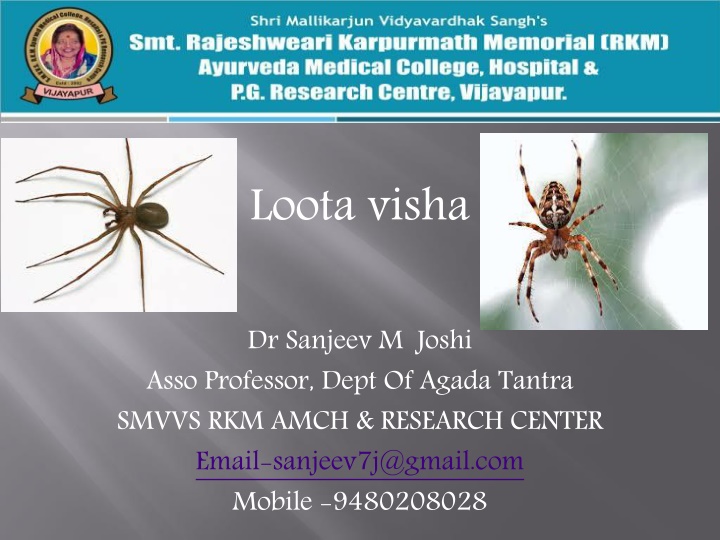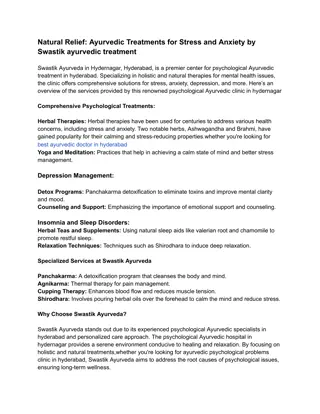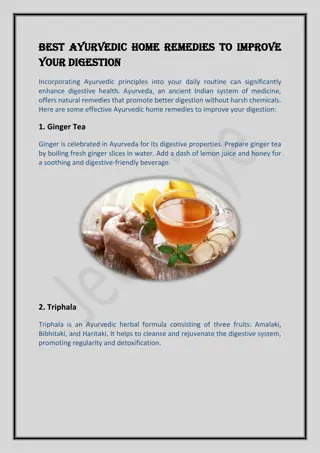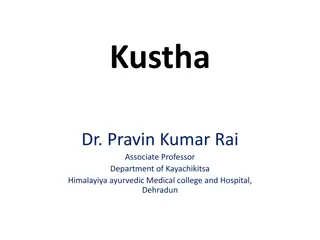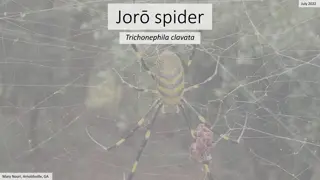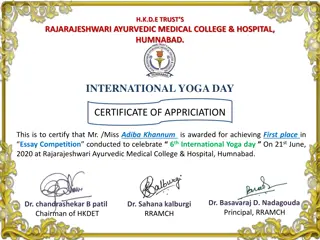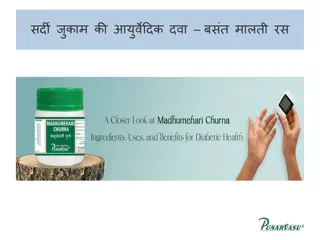Ayurvedic Approach to Spider Envenomation: Understanding Classification and Treatment
Ayurveda offers a unique perspective on spider bites, categorizing them based on dosha vitiation, poison action, site of venom, and prognosis. This article explores the classification of spider envenomation according to Ayurveda, emphasizing the clinical features and herbal treatment options. Understanding these classifications can aid in differentiating spider bites and utilizing traditional medicine for effective management.
Download Presentation

Please find below an Image/Link to download the presentation.
The content on the website is provided AS IS for your information and personal use only. It may not be sold, licensed, or shared on other websites without obtaining consent from the author.If you encounter any issues during the download, it is possible that the publisher has removed the file from their server.
You are allowed to download the files provided on this website for personal or commercial use, subject to the condition that they are used lawfully. All files are the property of their respective owners.
The content on the website is provided AS IS for your information and personal use only. It may not be sold, licensed, or shared on other websites without obtaining consent from the author.
E N D
Presentation Transcript
Loota visha Dr Sanjeev M Joshi Asso Professor, Dept Of Agada Tantra SMVVS RKM AMCH & RESEARCH CENTER Email-sanjeev7j@gmail.com Mobile -9480208028
There are more than 30,000 species of spiders and most of them are venomous. Spider bites also called as arachnidism, is an injury resulting by the bite of spider. Agada Tantra part of Ayurveda has different approach towards classification of spiders with its clinical features and treatment. In this article an attempt is made to conceptualize spider envenomation according to Ayurveda which will help not only for differential diagnosis of spider bites but also the easy availability of herbal medicine treatment .
Classification of Luta: 1 Based on Dosha vitiation Vaatika (Vaayavya) Paittika (Agneya) Shleshmika (Soumya) Sannipatika (Mishrika)
2. Based on Vishaprabhava (action of poison) Tikshna Visha (acutely and violently): Occurrence of death is within 7 days. a) b) Madhyama Visha (moderate): Occurrence of death is within 7 to 10 days . Manda Visha (mild): Occurrence of death is within 15 days. c)
3. Based on site of poison in Luta There are eight poisoning sites of spider. 1)Shvas (Breath), 2) Danshtra (Fangs), 3) Purish (Fecal matter), 4) Mutra (Urine), 5) Shukra (Semen), 6) Lalastrava (Saliva), 7) Nakha (Nails) and 8) Artava (Menstrual fluid)
4. Based on Sadhya-asadhyata (prognosis): Krrucha-sadhya (Hard to treat). Asadhya (Untreatable) a) b)
Clinical Features: 1. General Features: Appearance of a round shape with rash in white-black or red or yellow or bluish in color, soft elevated, its center is either black or blue and resembles as a net at its edges. Spreading in nature like visarpa (erysipelas), swollen, with burning sensation and severe pain, fever, undergoes quick ulceration or suppuration, exudation, sloughing, destruction of muscles, causes the wound if exudation gets touched to the other healthy parts .
2. Specific Features: a) According to Dosha Vitation: Vatika or Vayavya Luta: These are born from the soil and give rise to diseases of vata. swelling which is rough, blue in color, giving rise to pain in joints and bodyache. Paitika or Agneya Luta: These are born from sweat and give rise to diseases of pitta burning sensation, thirst, and formation of blebs (vesicles), fever and burning sensation all over the body
Sleshmika or Saumya Luta: These are born from eggs (ova) and give rise to diseases of kapha. hard swelling, white in color, itching and mild pain. Sannipatika or Mishrika Luta: These are also known as Upadika luta . It causes vitiation of three doshas. The poison of these luta spread rapidly causing fire like burning sensation all over body
b) According to site of poison in Luta: Breath: Poisoning by breath the person quickly develops swelling associated with fever and burning sensation. Fangs: The site has profound swelling associated with pricking pain and burning sensation. Excreta: There is swelling with foul smell, burning sensation, itching, pricking sensation, it ripens quickly and when ripe it is yellowish.
Urine: The swelling has red colored edges and black center, resembles a whirl, emits foul smell, spreads outwards and has burning sensation. Semen: The swelling resembles a tumor, is hard and very painful. Saliva: The site has pain; elevated rash which is not deep seated has mild pain, itching and soft to touch.
Nails: The site has eruptions, burning sensation, itching and feels as though hot smoke is coming out. Menstrual Fluid: Red colored eruption appears resembling garland.
According to Sadhya-asadhyata (prognosis): Kruchasadhya Luta: The bite from these spiders results in aching pain in the head, pain and itching at the site of bite and symptoms peculiar to the aggravated vata and kapha. Asadhya Luta: The bites from these spiders are marked by bleeding, fever, burning sensation, diarrhea, and disorders due to the concentrated action of all the three deranged doshas of the body and the bitten part putrifies .
Stages of Spider Envenomation: Acharya Vagbhata described different stages of spider envenomation in a daywise pattern. He also mentioned that the lesion at the site of bite does not manifest for half a day from the time of bite. First Day: It appears as though pricked by a needle, with no discoloration over the affected part; there will be slight itching and pain. Second Day: The site of bite is of raised edges, surrounded by eruptions with well change in color of skin, depressed in center and has itching .
Third Day: The patient suffers with fever, horripilation, red circular patches at the site with the shape of a saucer, with severe agonizing pain and discharge from hair follicles. Fourth Day: There is profound swelling causing fever, dyspnea and giddiness.
Fifth Day: It gives rise to symptoms of poisoning related to predominant dosha as per described in dosha vitiation. Sixth Day: The poison invades all the vital organs. Seventh Day: The poisoning results in death.
Treatment: The treatment measures for Luta visha is as follows: Nasya (Snuffing) : Nasal drops from herbs Shyama (Ocimum tenuliforum), Yavaphala( Trachyspermum ammi), seeds of Phanijjaka (Hyocyamus niger), and Shirisha (Albizia lebbeck) macerated with the juice of Vartaka (Solanum melongena) is best to remove the poison. And it also may be useful when there is heaviness of head, swelling, salivation and lock jaw.
Anjanam (Medicated Collyrium) : If disorders of vision, swelling and itching in the time are present at the time of onset of sleep, then the collyrium prepared from Vacha (Acorus calamus), Trikatu (Zingiber officinale + Piper longum + Piper nigrum), Triphala (Emblica officinalis + Terminalia bellerica + Terminalia chebula), Lodhra (Symplocos racemosa), Tamra (Copper), Mukta (Pearl) and Pravala (Coral) Abhyanga (Unguents) : Medicated ghee prepared with roots of Katabhi (Careya arborea), Tagara (Valeriana wallichi), Devadaru (Cedrus deodara), Brihati (Solanum indicum) and Chandana (Santalum album)
Panam (Potions) : Sarpakshi (Xanthium strumarium), Chandana (Santalum album), Gandhanakuli (Acampe praemorsa), Ela (Elletaria cardamomum + Amomum subulatum) is made into paste with Goats Urine is used for internal drink and external application. Dhupanam (Fumigation): Fumigation is done by antipoisonous drugs. Gandusha (Gargling): Gargling is done by antipoisonous drugs.
